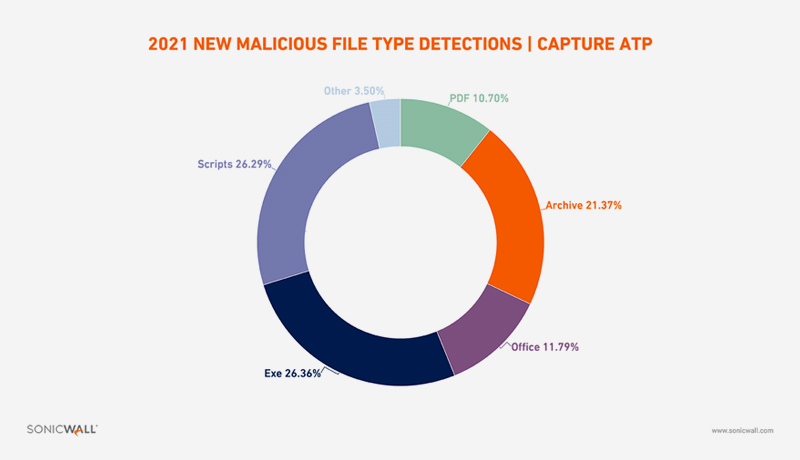22 December 2024, Sun |
8:18 PM

In the first half of 2021, ransomware attacks skyrocketed, eclipsing the entire volume for 2020 threat report. According to the mid-year update to the 2021 SonicWall Cyber Threat Report published, SonicWall: Recorded 304.7 million ransomware attacks within 6 months. In a new paradigm for cybercrime, SonicWall is analyzing how threat actors are using any means possible to further their malicious intents.
With high-profile attacks against established technology and infrastructure, ransomware is now more prevalent than ever. Through the first half of 2021, SonicWall recorded global ransomware volume of 304.7 million, surpassing 2020’s full-year total (304.6 million) — a 151% year-to-date increase.
“In a year driven by anxiety and uncertainty, cybercriminals have continued to accelerate attacks against innocent people and vulnerable institutions,” said SonicWall President and CEO Bill Conner.

Further stated, “This latest data shows that sophisticated threat actors are tirelessly adapting their tactics and embracing ransomware to reap financial gain and sow discord. With remote working still widespread, businesses continue to be highly exposed to risk, and criminals are acutely aware of uncertainty across the cyber landscape. It’s crucial that organizations move toward a modern Boundless Cybersecurity approach to protect against both known and unknown threats, particularly when everyone is more remote, more mobile and less secure than ever.”
After posting record highs in both April and May, SonicWall recorded another new high of 78.4 million ransomware attacks in June 2021 alone. Ransomware volume showed massive year-to-date spikes in the U.S. (185%) and the U.K. (144%). Accounting for 64% of all recorded ransomware attacks, Ryuk, Cerber and SamSam were the top three ransomware families in the first half of the year, as recorded by SonicWall Capture Labs.
The top five regions most impacted by ransomware in the first half of 2021 were the United States, United Kingdom, Germany, South Africa, and Brazil.
“The continued rise of ransomware, cryptojacking and other unique forms of malware targeted at monetization, along with their evolution of tactics, are evidence that cybercriminal activity always follows the money and rapidly adapts to new opportunities and changing environments,”said SonicWall Vice President of Platform Architecture Dmitriy Ayrapetov.
In line with spikes in global data, SonicWall Capture Labs threat researchers also recorded alarming ransomware spikes across key verticals, including government (917%), education (615%), healthcare (594%) and retail (264%) organizations.
In the fight against known and unknown threats, SonicWall’s patented Real-Time Deep Memory InspectionTM (RTDMI) identified record numbers of never-before-seen malware, posting a 54% year-to-date increase over the first half of 2020.
RTDMI technology blocks more advanced and unknown malware compared to traditional behavior-based sandboxing methods, and with a lower false-positive rate. This can be seen in the latest ICSA Labs Advanced Threat Defense (ATD) Q2 test results, where the SonicWall Capture Advanced Threat Protection (ATP) service with RTDMI detected 100% of previously unknown threats with zero false positives across 33 consecutive days of testing.
In its most recent test administered in the second quarter of 2021, ICSA conducted a total of 1,144 tests against Capture ATP, with a mixture of 544 new and little-known malicious samples and 600 innocuous applications. Capture ATP correctly identified 100% of malicious samples while allowing all clean samples through. It was the sixth consecutive ICSA ATD certification for Capture ATP, and second ‘perfect score’ in as many quarters.
“Third-party validation is hard earned, particularly in today’s fast-moving threat landscape,” said SonicWall Vice President of Software Engineering & Threat Research Alex Dubrovsky. “Consecutive perfect certifications is a testament to the SonicWall team and our continued quest to arm organizations with intelligence and technology that help protect them from the most dangerous cyber threats.”

Last year, SonicWall recorded a drop in global malware attacks, a trend that continued in the first half of 2021 with a 24% drop in malware volume worldwide. As threat actors become more sophisticated — using ransomware, cryptojacking and other types of cyberattacks to launch surgical strikes — the need for “spray-and-pray” malware attempts has lessened, decreasing overall volume.
Malware attacks via non-standard ports also fell in 2021 after hitting record highs in 2020. These attacks, which aim to increase payloads by bypassing traditional firewall technologies, represent 14% of all malware attempts in the first half of 2021, down from 24% year to date.
After having made an unexpected revival in 2020, cryptojacking malware continued to climb through the first half of 2021 as cryptocurrency prices remain high. From January to June, SonicWall threat researchers recorded 51.1 million cryptojacking attempts, representing a 23% increase over the same six-month period last year.
Europe was particularly ravaged, recording a 248% year-to-date rise in cryptojacking malware. This increase highlights the volatile shifts of a market cybercriminals have come to leverage due to their high desire for online anonymity when it comes to lucrative payouts.
Last year, employees packed their belongings and went home in droves, introducing millions of new devices to the network and millions of openings for cybercrime. This year, Internet of Things (IoT) malware attacks have continued to increase, rising 59% year-to-date globally, a trend stemming back to 2018.
While the U.S. saw a slightly smaller 15% year-to-date increase in IoT malware, Europe and Asia also saw alarming rises of 113% and 190%, respectively, in IoT malware volume.
SonicWall Capture Labs threat researchers collect and analyze threat intelligence data from 1.1 million sensors in over 215 countries and territories. This includes cross-vector, threat-related information shared among SonicWall security systems, including firewalls, email security devices, endpoint security solutions, honeypots, content filtering systems and the SonicWall Capture Advanced Threat Protection (ATP) multi-engine sandbox; SonicWall internal malware analysis automation framework; malware and IP reputation data from tens of thousands of
firewalls and email security devices around the globe; and shared threat intelligence from more than 50 industry collaboration groups and research organizations.
To download the full mid-year update of the 2021 SonicWall Cyber Threat Report, please visit www.sonicwall.com/threatreport.